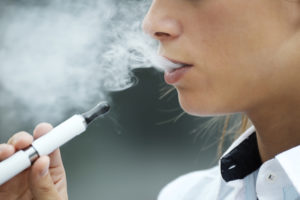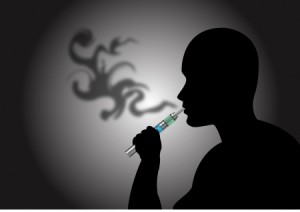E-Cigarettes Are Just Unhealthy

The pros and cons of e-cigarettes have been trading studies and expert opinions back-and-forth for a number of years. In “Nicotine without smoke: tobacco harm reduction,” The Royal College of Physicians sees e-cigarettes as “an ideal tobacco harm reduction product.” While acknowledging that e-cigarettes are not currently made to medical standards and are probably more hazardous than nicotine replacement therapy (NRT), the report said it was unlikely that the health risks from long-term vapor inhalation would exceed 5% of the harm from smoking tobacco. The report also downplayed concerns that e-cigarettes will increase tobacco smoking and act as a gateway to smoking in younger people. But this strong endorsement is not the last word on the saga of e-cigarettes.
Writing for AfterParty Magazine, Tracy Chabala pointed to a study published in the New England Medical Journal raising the danger of inhaling formaldehyde at concentration levels higher than that of nicotine. If that doesn’t good healthy, you’re correct. Formaldehyde is a known cancer-causing agent, and “How formaldehyde-releasing agents behave in the respiratory tract is unknown.” The study authors calculated the risk from e-cigarettes to be 5 to 15 times as high as the risk of long-term smoking. What’s more, “formaldehyde-releasing agents may deposit more efficiently in the respiratory tract than gaseous formaldehyde, and so they could carry a higher slope factor for cancer.”
In her article,“Can Your E-Cigarette Give You Cancer?,” Tracy Chabala noted there were several strong opinions on the study. A lawyer for the American Vaping Association said the study used the vaping device “in a manner that no one does.” He likened it to leaving a steak on the grill all day—“many cancer-causing substances might be formed but no one would eat such charred works.” I’m not sure I buy his analogy, that vaping with an e-cigarette is like having a good steak on the grill. But his point seems to be that one limit of the study was that the researchers based their findings on a method of using their devise that no one actually does when vaping.
What the study actually reported was that they used an e-cigarette with a “tank system” and a variable-voltage battery. The aerosolized liquid was collected in an NMR spectroscopy tube over five minutes with each puff of their device taking 3 to 4 seconds. They did not find any formaldehyde-releasing agents at the low voltage setting. However, they did detect agents at the high voltage setting. The lawyer for the American Vaping Association seems to have overplayed his analogy. A biologist from the American Cancer Society said he was reasonably convinced that all the formaldehyde released during the test tube studies would likely break down into formaldehyde in the e-smoker’s lungs. I think I’m going with the opinion of the biologist on this one.
The President of The Cancer Action Network, an advocacy group of the American Cancer Society, urged the federal government to consider the new findings and finalize its proposal to regulate all tobacco products, including e-cigarettes. The findings were just another example of how little is known about these products or the varying levels of exposure to toxic chemicals that can result from using any of the hundreds of different types of e-cigarette devices. He said federal regulation was imperative to help address the health risks of e-cigarettes and others who are exposed to e-cigarette vapor. “Furthermore, until the FDA finalizes its proposal to regulate e-cigarettes and other tobacco products, the industry’s unfettered ability to market these products to kids remains a threat to public health.”
In May of 2016, David Nather reported for STAT News that the FDA issued a set of rules regulating e-cigarettes for the first time, despite strong resistance from the industry. All states would now be required to ban the sale of e-cigarettes to anyone under the age of 18. All devices that went on sale after February 15, 2007 would be subject to FDA review unless the manufacturers can prove their products are ”substantially equivalent” to products being sold or that there is another reason they should be exempt. Dr. Robert Cardiff, the FDA commissioner said: “Today’s rule is a milestone in consumer protection. It marks a new chapter in our efforts to do everything we can under the law to protect Americans from the dangers of tobacco products.”
Manufacturers would have between a year and two years to prepare their applications, depending on whether they are submitting to the reviews or arguing they should be exempt. Then they would have another year to win approval from the FDA. The rule would not ban flavored tobacco products, including e-cigarettes. But the FDA is working on a rule that would restrict cigar companies from using flavors in their marketing just as cigarette makers can’t include flavors in their sales pitches.
The president of the American Vaping Association said it was a big win for American cigarette companies and a giant loss for small businesses. He predicted that in two or three years, “nearly every vape shop in the country will be closed.” I’m not sure that would be such a bad thing. It seems that the rhetoric pitting Big Tobacco against little vape shops has ignored the real concern over the potential health hazards of vaping instead of smoking tobacco products.
While acknowledging there are anecdotal reports that some people have used e-cigarettes to stop smoking, Mitch Zeller of the FDA said the agency needed more data on how e-cigarettes are being used, including how many people who use e-cigarettes never used tobacco products before. “I hope everyone can agree that kids should not initiate on e-cigarettes simply because of the harm that can come from nicotine.”
Lobbyists for the cigar and e-cigarette industries pushed Congress to create bills that would either exempt them from the new rules or grandfather in products already on the market. Representative Tom Cole of Oklahoma, the chairman of the House subcommittee funding health programs, added a measure to the FDA’s funding bill for next year that would get rid of the February 2007 effective date. Cole said his legislation “provides the same framework for new tobacco products without needlessly subjecting small businesses to unnecessary regulations and without treating law abiding adults like naïve children.”
Mitch Zeller noted that Cole’s measure would eliminate all reviews of e-cigarette products that came on the market after 2007 (the vast majority of them) and clear the way for future products that are similar in design. The proposal “would have an enormously adverse impact on public health and the ability of FDA to do its job.” Beginning on August 8, 2016, the FDA will start regulating e-cigarettes, all cigars, waterpipes (hookahs), tobacco, pipe tobacco, and nicotine gels.
So this leads us to the newest published study of e-cigarettes in the journal Environmental Science & Technology by Sieiman et al., “Emissions from Electronic Cigarettes.” Their study found that all electronic cigarettes emit harmful chemicals. Levels of those toxic compounds are affected by factors in the use of e-cigarettes such as temperature, and the type and age of the device.
A news release from Berkley Lab said the study found that the thermal decomposition of propylene glycol and glycerin leads to the emissions of toxic chemicals such as acrolien and formaldehyde. Propylene glycol and glycerin are found in most e-liquids, the substance vaporized in e-cigarettes. There were 31 different toxic chemicals found at significant levels in e-cigarette vapor. Hugo Destailats, one of the researchers said that while it may be true emissions are much lower from e-cigarettes than conventional ones, that’s only true for certain users, for example, long time smokers who cannot quit. “Regular cigarettes are super unhealthy. E-cigarettes are just unhealthy.”
One of their findings indicated there was a big difference in emissions between the first and last puffs. They found that vapor temperature rose quickly in the first 5 to 10 minutes until it reached a steady state temperature around the twentieth puff. Emission levels between the first few puffs and the steady state increased by a factor of ten of more. Factors affecting the levels included the device used, the battery voltage and the emitted compound.
In order to test effects due to the device aging, the researchers used a single device over nine consecutive 5-puff cycles without cleaning it. Emissions for formaldehyde, acetaldehyde, and acrolein, which are all irritants or carcinogens, increased. “In some cases we saw formaldehyde levels increase 60 percent between cycles 1 and 9.”
This effect is consistent with the buildup of polymerization byproducts on or near the coil leading to accumulation of the sort of residues that are often referred to in the blogosphere as ‘coil gunk’ or ‘caramelization.’ Heating these residues would provide a secondary source of volatile aldehydes.
Looking at the effect of voltage on emissions, the researchers found that as the voltage increased, both the amount of e-liquid consumed per puff and the vapor temperature were higher. Destailats pointed out this did not mean e-cigarettes were safer to use at lower temperatures. “We found there are emissions of toxic chemicals at any temperature at which you use the device. . . . And the higher the temperature, the more emissions.”
This won’t be the last word in the e-cigarette saga. The back-and-forth conflict is just getting started. You should also keep in mind there is another aspect to the e-cigarette conflict. E-cigarettes are modified or “hacked” to smoke marijuana—dry herb, hash oil or THC liquids. They’re called, ironically, e-joints. See “E-Cigarettes and E-Joints” or do your own Google search.

